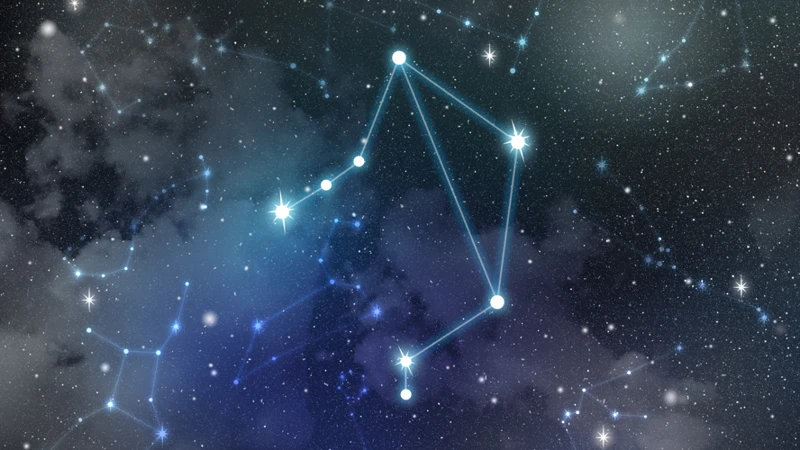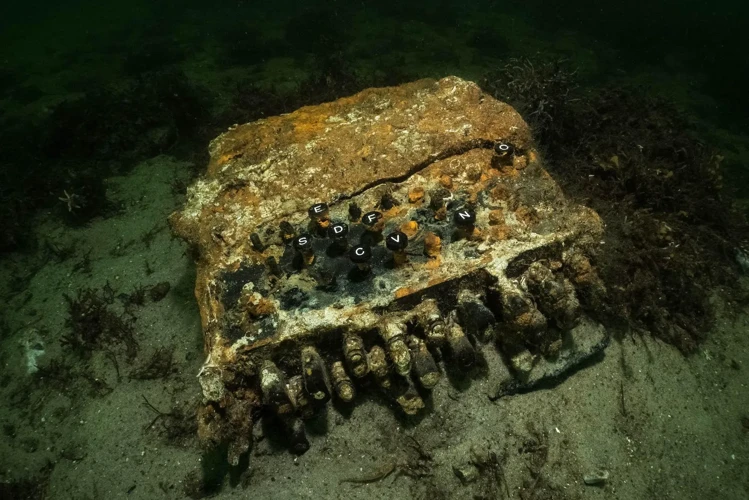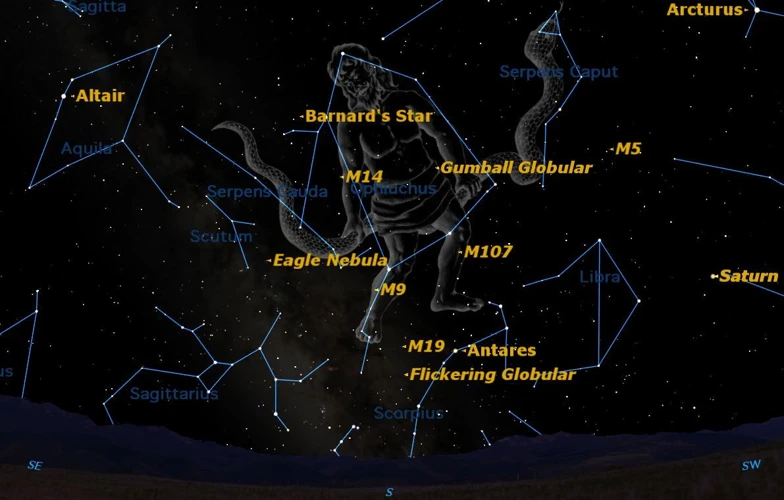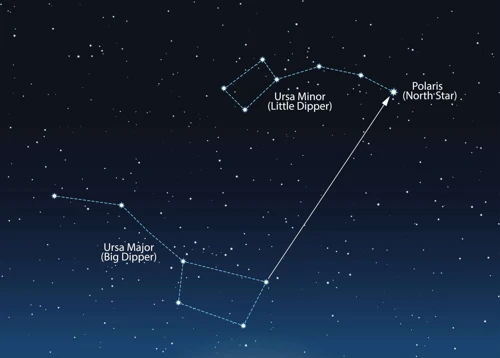What is the mysterious connection between the night sky’s shining stars and ancient mythology? One captivating tale lies in the celestial figures of Ursa Major and Ursa Minor, commonly known as the Big and Little Dipper. These prominent constellations have fascinated cultures around the world for centuries. In this article, we will delve into the mythological origins of Ursa Major and Ursa Minor, exploring the fascinating stories that have been passed down through generations. From the Greek myth of Callisto and her transformation into a bear, to the Roman tale of Arcas and his mother’s divine intervention, we will uncover the rich tapestry of legends that surround these celestial formations. Join us on this journey as we delve into the captivating stories, symbolism, and scientific discoveries that make Ursa Major and Ursa Minor shine brightly in the realm of mythology and astronomy.
The Story of Callisto

The captivating tale of Callisto begins with a skilled huntress who caught the eye of the mighty god Zeus. Callisto, a mortal woman and a companion of the goddess Artemis, was known for her beauty and prowess in hunting. However, her life took a dramatic turn when Zeus disguised himself as Artemis and approached Callisto in the woods. Unaware of Zeus’ true identity, Callisto was seduced by him and became pregnant. When Artemis discovered Callisto’s pregnancy, she banished her from the group. In time, Callisto gave birth to a son named Arcas. However, the situation took a tragic twist when Hera, the jealous wife of Zeus, learned of his infidelity. In her anger, Hera transformed Callisto into a bear, forever altering her human form. This dramatic metamorphosis not only served as a punishment but also as a means to conceal Callisto’s identity from Zeus. The story of Callisto and her transformation into a bear is a captivating myth that touches upon themes of love, betrayal, and the consequences of divine involvement in mortal affairs. To learn more about other intriguing stories from Greek mythology, check out our article on the enigmatic history of Pegasus or the unraveling of the Pleiades mystery.
The Huntress and the Bear
In the mesmerizing tale of “The Huntress and the Bear,” we are introduced to Callisto, a skilled huntress and companion of the goddess Artemis. This part of the story focuses on the beginning of Callisto’s encounter with Zeus, who disguises himself as Artemis to approach her. Unaware of Zeus’ true identity, Callisto is seduced by him, leading to an unexpected pregnancy. The consequences of this affair are severe, as Callisto is expelled from the group by Artemis upon discovering her pregnancy. As Callisto gives birth to a son named Arcas, her life takes a tragic turn when Hera, the wife of Zeus, learns of the infidelity. In her anger and jealousy, Hera takes action and transforms Callisto into a bear, forever changing her human form. This transformation serves as a punishment for Callisto’s involvement with Zeus and a means to hide her identity from him. This part of the story lays the foundation for the subsequent events, intertwining themes of love, betrayal, and the boundaries between mortal and divine. To explore more captivating tales from Greek mythology, delve into the intriguing history of Pegasus, the iconic winged horse.
Transformation and Divine Intervention
The myth of Callisto is marked by a significant event: her transformation and divine intervention. After giving birth to her son Arcas, Callisto faced the wrath of Hera, who transformed her into a bear as punishment for her relationship with Zeus. This transformation was not merely a physical alteration but a profound change that impacted Callisto’s entire existence. As a bear, Callisto was forced to adapt to a new way of life, navigating the world with animal instincts instead of her human consciousness. This divine intervention served as a means to protect Callisto from Zeus’ wrath and Hera’s jealousy by concealing her true identity. The transformation into a bear symbolized the loss of her humanity and the introduction of a new, primal existence. It also emphasized the consequences of meddling in the affairs of gods and the unpredictable outcomes that can arise when mortals become entangled in divine affairs. This remarkable transformation and subsequent divine intervention play a crucial role in shaping Callisto’s story and leave a lasting mark on the mythological narrative surrounding Ursa Major and Ursa Minor.
The Tale of Arcas

The poignant tale of Arcas, the son of Callisto, intertwines tragedy and divine intervention. Unaware of his mother’s fate, Arcas grew up in the wilderness as a skilled hunter, eventually catching the attention of his grandfather, Zeus. As Zeus looked upon his grandson with love, Hera’s jealousy resurfaced. Fearing another reminder of Zeus’ infidelity, Hera plotted to harm Arcas. In a dreadful turn of events, she caused Arcas to accidentally shoot and mortally wound his own mother while out hunting. Overwhelmed with grief and guilt, Arcas was unaware that his actions were a result of Hera’s manipulations. Just as tragedy seemed to consume him, Zeus intervened once again, transforming Arcas into the constellation Ursa Minor, or the Little Bear, and placing him alongside his mother, the constellation Ursa Major, in the night sky. This divine act not only immortalized Arcas and his mother but also serves as a poignant reminder of the complex relationship between gods and mortals and the consequences of their actions in Greek mythology.
A Mother’s Grief and a Son’s Ignorance
In the tale of “A Mother’s Grief and a Son’s Ignorance,” the story continues with Callisto’s transformation into a bear. As a bear, Callisto wandered the forests, trying to adapt to her new existence. Meanwhile, her son Arcas grew up unaware of his mother’s fate. One day, while hunting in the woods, Arcas came across a bear – unaware that it was his own mother. Unbeknownst to him, the bear was none other than Callisto, desperately hoping for a reunion with her son. Filled with fear, Arcas drew his bow and prepared to shoot the bear. However, just as he released the arrow, Zeus, who had been watching the events unfold, intervened. The king of the gods saw the tragic misunderstanding and swiftly transformed Arcas into a bear as well. In this act, Zeus not only saved Callisto from her son’s arrow but also reunited a grieving mother with her child. From that moment on, Callisto and Arcas were immortalized as Ursa Major and Ursa Minor, their images forever captured in the starry night sky. This heart-wrenching tale of a mother’s grief and a son’s ignorance serves as a reminder of the enduring power of family bonds and the profound consequences of our actions.
Gods Intervene Once Again
In the tale of Callisto, the gods intervened once again, shaping the destiny of both Callisto and her son, Arcas. As Callisto roamed the forest in her new bear form, she kept a watchful eye over her son from a distance. Years passed, and Arcas grew into a skilled hunter, unknowingly drawing closer to his mother. One fateful day, as Arcas was hunting in the wilderness, he encountered the bear that was once his mother. Unaware of the bear’s true identity, Arcas took aim with his bow and arrow, ready to strike. However, just as he released the arrow, Zeus intervened, freezing both Arcas and Callisto in time. In that moment, Zeus transformed Callisto back into her human form, and she and Arcas were immortalized as two constellations in the night sky – Ursa Major and Ursa Minor. Together, they would forever be linked as mother and son in the celestial realm, a testament to the gods’ intervention and the enduring bonds of familial love. The gods’ intervention in the tale of Callisto serves as a reminder of their immense power and influence in mortal lives, shaping destinies and leaving lasting imprints on the world.
Across Cultures

Across different cultures, Ursa Major and Ursa Minor have captured the imagination and held significant mythological significance. In Greek mythology, these constellations are associated with the story of Callisto and her transformation into a bear, as mentioned earlier. However, the fascination with these celestial formations extends beyond Greek legends. In Roman mythology, the constellations are linked to the tale of Arcas, the son of Callisto. Native American cultures also have their own lore surrounding Ursa Major and Ursa Minor. For instance, the Ojibwe people view these constellations as a bear and a hunter, while the Lakota Sioux regard them as a group of seven brothers and a bear. The cultural diversity in the interpretations of Ursa Major and Ursa Minor reflects the universal human fascination with the stars and the myths that arise from them. Whether it is the stories of the ancient Greeks, the Romans, or the indigenous peoples of the Americas, these constellations hold a deep cultural significance and continue to inspire awe and wonder across different parts of the world.
Greek Mythology
Greek Mythology is a vast and intricate tapestry of stories, gods, and heroes that have captivated generations. When it comes to Ursa Major and Ursa Minor, Greek mythology holds a significant place in their origin tales. These celestial formations are closely associated with the Greek myth of Callisto and her transformation into a bear. Callisto, a member of Artemis’ hunting party, caught the eye of Zeus and fell victim to his advances. The consequences of this forbidden romance were swift and dramatic. Callisto’s transformation into a bear was a result of Hera’s wrath upon learning of Zeus’ infidelity. This myth not only explains the origins of the constellations but also explores themes of love, betrayal, and the whims of the gods. The story of Callisto and her connection to Ursa Major and Ursa Minor is a testament to the enduring power of Greek mythology and its ability to weave rich narratives that continue to fascinate and inspire.
Roman Mythology
Roman mythology, with its rich tapestry of gods and legends, also has its own interpretation of the Ursa Major and Ursa Minor constellations. In Roman mythology, Ursa Major represents the figure of Callisto, just as in Greek mythology. However, the story takes a slightly different turn. In Roman mythology, Callisto is a beautiful nymph who catches the eye of the ancient deity Jupiter, who is equivalent to Zeus in Greek mythology. Jupiter disguises himself as Diana, the Roman counterpart of Artemis, and seduces Callisto, resulting in her pregnancy. The goddess Juno, Jupiter’s wife and counterpart to Hera, discovers the affair and seeks revenge. Juno transforms Callisto into a bear, banishing her to roam the forest. Ursa Minor in Roman mythology represents the figure of Arcas, the son of Callisto and Jupiter. This constellation is said to symbolize Arcas as a young hunter, forever looking up at his transformed mother, who is represented by Ursa Major. The story of Callisto and Arcas in Roman mythology brings elements of forbidden love, divine punishment, and the enduring bond between a mother and her child.
Native American Mythology
Native American mythology offers its own captivating interpretation of the Ursa Major and Ursa Minor constellations. Various tribes across North America have woven unique narratives around these celestial figures. For example, the Lakota Sioux people identify Ursa Major as a sacred bear symbolizing courage and healing. They believe that the Great Bear constellation guides warriors in battle and provides protection. In contrast, the Cheyenne people view Ursa Major as the “Buffalo Bull’s Soldiers,” representing the seven buffalo bulls that once rescued their ancestors during a time of drought and starvation. Similarly, the Iroquois people observe Ursa Major as the Sky Holder, responsible for supporting the heavens. They believe that if Ursa Major were to ever fall, the entire sky would collapse. Such diverse interpretations across Native American cultures highlight the rich tapestry of mythology and the deep connection between the natural world and spiritual beliefs.
Symbolism and Cultural Significance

Symbolism and Cultural Significance hold a significant place in the mythology and interpretations surrounding Ursa Major and Ursa Minor. These celestial formations have been imbued with various symbolic meanings across different cultures. In Greek mythology, Ursa Major and Ursa Minor are often associated with the story of Callisto and her transformation into a bear. Bears, in general, were seen as powerful and protective animals, and their presence in the night sky represented strength and guardianship. The Big Dipper, a prominent part of Ursa Major, has been used as a guiding tool for navigation, symbolizing direction and guidance. In Roman mythology, Ursa Major and Ursa Minor were associated with the goddess Juno, the protector of women and marriage. The constellations played a role in marriage ceremonies, symbolizing fidelity and marital commitment. Additionally, Native American cultures also recognized these constellations, often referring to them as the Great Bear and the Little Bear. The varied interpretations of Ursa Major and Ursa Minor reflect the rich tapestry of cultural beliefs and values passed down through generations. The symbolism surrounding these constellations signifies different aspects such as strength, protection, guidance, and marital fidelity, making them an integral part of the cultural fabric of various civilizations.
Scientific Discoveries
The exploration of Ursa Major and Ursa Minor extends beyond mythology and delves into the realm of scientific discoveries. Scientists and astronomers have made significant strides in understanding the mysteries of these constellations. One fascinating aspect of scientific research is the study of stellar evolution and distances. Through advanced telescopes and observation techniques, astronomers have gained insights into the life cycle of stars within Ursa Major and Ursa Minor. They have discovered the birth, evolution, and eventual demise of stars, shedding light on the cosmic processes that shape our universe. Additionally, modern understanding of these constellations has provided us with valuable knowledge about their composition, structure, and movements in the night sky. Studying Ursa Major and Ursa Minor has not only deepened our understanding of the universe but also reinforced the timeless connection between mythology and the wonders of the cosmos.
Stellar Evolution and Distances
When it comes to understanding the fascinating world of stellar evolution and distances, we are transported far beyond the realms of mythology and into the depths of scientific exploration. Stars, including those forming Ursa Major and Ursa Minor, have their own life cycles that span millions and even billions of years. They begin as vast clouds of gas and dust, known as nebulae, which gradually collapse under gravity’s pull. As these nebulae condense, the central core grows hotter and denser, eventually igniting nuclear fusion. This fusion process releases an enormous amount of energy, transforming the star into a brilliant ball of fire. Over time, stars can undergo various stages of evolution, including the red giant phase, where they expand and become even brighter. But what about the distances between these celestial bodies? Astronomers use a variety of techniques to measure these vast cosmic distances. One common method is parallax, which involves observing the apparent shift in a star’s position as the Earth orbits around the Sun. Through meticulous calculations and measurements, scientists can determine the distance between Earth and the stars, providing valuable insights into the vastness of our universe. The study of stellar evolution and distances not only enhances our understanding of these celestial bodies but also allows us to appreciate the intricate journey of creation and transformation taking place among the stars.
Modern Understanding
Modern Understanding of Ursa Major and Ursa Minor has come a long way with advancements in astronomical research and technology. Today, astronomers have a profound understanding of the nature and composition of these constellations. Scientific studies have revealed that Ursa Major and Ursa Minor consist of a collection of stars that appear close together from Earth’s perspective but are actually located at different distances from us. The stars in these constellations vary in size, temperature, and brightness. Through the use of telescopes and spectroscopy, scientists have been able to analyze the spectra of these stars, providing crucial information about their chemical composition and evolutionary stages. This has led to a deeper understanding of stellar evolution, demonstrating how stars are born, evolve, and eventually die. Additionally, astronomers have been able to measure the distances to stars in Ursa Major and Ursa Minor using techniques such as parallax and spectroscopic parallax. These measurements have allowed scientists to create accurate three-dimensional models of the constellations and to determine their positions in the Milky Way galaxy. The modern understanding of Ursa Major and Ursa Minor not only enhances our knowledge of these celestial formations but also contributes to our understanding of the universe as a whole.
Conclusion
In conclusion, the mythological origins of Ursa Major and Ursa Minor have captivated cultures and individuals throughout history. These celestial constellations, represented by the Big and Little Dipper, hold a rich tapestry of stories that stretch across Greek, Roman, and Native American mythology. The tale of Callisto and her transformation into a bear highlights themes of love, betrayal, and divine intervention, while the story of Arcas explores the consequences of a mother’s grief and the meddling of gods. These myths not only reveal the complex relationships between gods and mortals but also reflect cultural values and beliefs. Moreover, Ursa Major and Ursa Minor have transcended their mythological origins to become powerful symbols in various cultures, representing strength, guidance, and endurance. From a scientific standpoint, the discoveries related to stellar evolution and distances have further deepened our understanding of these celestial formations. As we gaze upon the awe-inspiring night sky, we are reminded of the vastness of the universe and the enduring legacy of mythology. The legends of Ursa Major and Ursa Minor continue to inspire and ignite our imaginations, reminding us of the timeless beauty and wonder that lie within the stars above.
Frequently Asked Questions
1. What is the significance of Ursa Major and Ursa Minor in mythology?
Ursa Major and Ursa Minor hold great significance in mythology as they have been featured in various ancient tales from different cultures. These constellations have been associated with powerful gods, tragic love stories, and divine interventions.
2. How did Ursa Major and Ursa Minor acquire their names?
The names Ursa Major and Ursa Minor have Latin origins, which translate to “Great Bear” and “Little Bear” respectively. These names were given due to the resemblance these constellations have to the shape of bears.
3. What is the story of Callisto and her connection to Ursa Major?
Callisto was a huntress who became a constellation in Greek mythology. Her story involves a forbidden affair with Zeus, the king of the gods, and her subsequent transformation into a bear by Zeus’ jealous wife, Hera. Callisto’s transformation into a bear led to her being immortalized as the constellation Ursa Major.
4. Who is Arcas and what is his connection to Ursa Minor?
Arcas was the son of Callisto and Zeus. In the myth, Arcas unknowingly almost kills his mother while hunting. To prevent this tragedy, Zeus transforms Arcas into a bear as well and places him in the sky as the constellation Ursa Minor.
5. Are there variations of the Ursa Major and Ursa Minor myths in different cultures?
Absolutely! While the Greek and Roman myths are well-known, there are variations of these stories in other cultures as well. Native American cultures, for example, have their own fascinating myths and legends associated with these constellations.
6. How did Ursa Major and Ursa Minor become important symbols in various cultures?
Ursa Major and Ursa Minor have been seen as significant symbols representing power, protection, and guidance across cultures. Their prominent presence in the night sky made them a source of inspiration and awe, often associated with mythical stories and celestial navigation.
7. What scientific discoveries have aided our understanding of Ursa Major and Ursa Minor?
Astronomical advancements have provided us with a better understanding of the stars in Ursa Major and Ursa Minor. Stellar evolution theories, insights into star distances, and observational data have allowed scientists to unravel the mysteries behind these constellations.
8. How can one locate Ursa Major and Ursa Minor in the night sky?
Locating Ursa Major and Ursa Minor is relatively easy. Ursa Major is recognized by the shape of the Big Dipper, which is formed by its seven brightest stars. Ursa Minor, on the other hand, is identifiable by the Little Dipper pattern, which includes the North Star, also known as Polaris.
9. What other constellations are closely associated with Ursa Major and Ursa Minor?
Ursa Major and Ursa Minor share the night sky with other notable constellations. Ursa Major neighbors the constellation Draco, while Ursa Minor is accompanied by Cepheus and the constellation of the Dragon’s Head, known as the constellation Hercules.
10. How have Ursa Major and Ursa Minor influenced popular culture?
The enduring allure of Ursa Major and Ursa Minor can be seen in their influence on various aspects of popular culture. From literature and art to astrology and astronomy, these constellations have sparked creativity and imagination, leaving an indelible mark on human expression.








